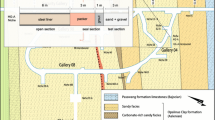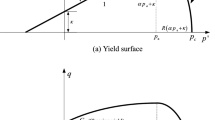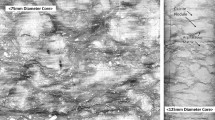Abstract
Production of energy from nuclear power plants generates high-level radioactive nuclear waste, harmful during dozens of 1000 years. Deep geological disposal of nuclear waste represents a reliable solutions for its safe isolation. Confinement of radioactive wastes relies on the multi-barrier concept in which isolation is provided by a series of engineered (canister, backfill) and natural (host rock) barriers. Few underground research laboratories have been built all over the world to test and validate storage solutions. The drilling of disposal drifts may generate cracks, fractures/strain localisation in shear bands within the rock surrounding the gallery especially in argillaceous rocks. These degradations affect the hydro-mechanical properties of the material, such as permeability, e.g., creating a preferential flow path for radionuclide migration. Hydraulic conductivity increase within this zone must remain limited to preserve the natural barrier. In addition, galleries are currently reinforced by different types of concrete supports such as shotcrete and/or prefab elements. Their purpose is twofold: avoiding partial collapse of the tunnel during drilling operations and limiting convergence of the surrounding rock. Properties of both concrete and rock mass are time dependent, due to shotcrete hydration and hydro-mechanical couplings within the host rock. By the use of a hydro-mechanical coupled finite-element code with a second-gradient regularization, this paper aims at investigating and predicting support and rock interactions (convergence and stress field). The effect of shotcrete hydration evolution, spraying time, and use of compressible wedges is studied to determine their relative influence.
























Similar content being viewed by others
References
Agency IAE (2004) From Obninsk beyond: nuclear power conference looks to future. https://www.iaea.org/newscenter/news/obninsk-beyond-nuclear-power-conference-looks-future. Accessed 11 Nov 2010
Feiveson H, Mian Z, Ramana M, von Hippel F (2011) Managing nuclear spent fuel: policy lessons from a 10-country study. Bull Atom Sci 27:27
Agency ONE (1995)The environmental and ethical basis of geological disposal of longlived radioactive wastes. A collective opinion of the Radioactive Waste Management Committee of the OECD Nuclear Energy Agency. Technical report
Andra D (2005) Evaluation of the feasibility of a geological repository in an argillaceous formation. Andra, Chatenay-Malabry
Félix B, Lebon P, Miguez R, Plas F (1996) A review of the andra’s research programmes on the thermo-hydromechanical behavior of clay in connection with the radioactive waste disposal project in deep geological formations. Eng Geol 41(1–4):35–50
Blümling P, Bernier F, Lebon P, Martin CD (2007) The excavation damaged zone in clay formations time-dependent behaviour and influence on performance assessment. Phys Chem Earth Parts A/B/C 32(8):588–599
Armand G, Leveau F, Nussbaum C, de La Vaissiere R, Noiret A, Jaeggi D, Landrein P, Righini C (2014) Geometry and properties of the excavation-induced fractures at the meuse/haute-marne url drifts. Rock Mech Rock Eng 47(1):21–41
Pietruszczak S, Lydzba D, Shao J-F (2002) Modelling of inherent anisotropy in sedimentary rocks. Int J Solids Struct 39(3):637–648
Pardoen B, Talandier J, Collin F (2016) Permeability evolution and water transfer in the excavation damaged zone of a ventilated gallery. Int J Rock Mech Min Sci 85:192–208
Collin F, Chambon R, Charlier R (2006) A finite element method for poro mechanical modelling of geotechnical problems using local second gradient models. Int J Numer Method Eng 65(11):1749–1772
Oreste P, Pella D (1997) Modelling progressive hardening of shotcrete in convergence-confinement approach to tunnel design. Tunn Undergr Sp Technol 12(3):425–431
Bryne L (2014) Time dependent material properties of Shotcrete for hard rock tunneling. PhD thesis, KTH Stockholm
Kim J, Ryu J, Hooton R (2008) Evaluation of strength and set behavior of mortar containing shotcrete set accelerators. Can J Civ Eng 35(4):400–407
Won J, Hwang U-J, Kim C, Lee S (2013) Mechanical performance of shotcrete made with a high-strength cement-based mineral accelerator. Constr Build Mater 49:175–183
Bryne L, Ansell A, Holmgren J (2014) Laboratory testing of early age bond strength of shotcrete on hard rock. Tunn Undergr Sp Technol 41(1):113–119
Charron J-P, Marchand J, Bissonnette B, Gérard B (2001) Étude comparative de modèles phénoménologiques décrivant le comportement au jeune âge du béton. Partie 1. Can J Civ Eng 28(2):323–331
Charron J-P, Marchand J, Bissonnette B, Gérard B (2001) Étude comparative de modèles phénoménologiques décrivant le comportement au jeune âge du béton. Partie 2. Can J Civ Eng 28(2):323–331
De Schutter G (1999) Degree of hydration based Kelvin model for the basic creep of early age concrete. Mater Struct 32:260–265
Tazawa E-I, Miyazawa S (1995) Influence of cement and admixture on autogenous shrinkage of cement paste. Cem Concr Res 25(2):281–287
Kolani B, Buffo-Lacarrière L, Sellier A, Escadeillas G, Boutillon L, Linger L (2012) Hydration of slag-blended cements. Cement Concr Compos 34(9):1009–1018
Briffaut M, Benboudjema F, Torrenti J-M, Nahas G (2012) Concrete early age basic creep: experiments and test of rheological modelling approaches. Constr Build Mater 36:373–380
Gutsch A (2002) Properties of early age concrete–experiments and modelling. Mater Struct 35(246):76–79
van Breugel K (1995) Numerical simulation of hydration and microstructural development in hardening cement-based materials. (I) theory. Cem Concr Res 25(2):319–331
Buffo-Lacarrière L, Sellier A, Escadeillas G, Turatsinze A (2007) Multiphasic finite element modeling of concrete hydration. Cem Concr Res 37(2):131–138
De Schutter G, Taerwe L (1996) Degree of hydration-based description of mechanical properties of early age concrete. Mater Struct 29(6):335–344
Gawin D, Pesavento F, Schrefler BA (2007) Modelling creep and shrinkage of concrete by means of effective stresses. Mater Struct 40(6):579–591
Hilaire A, Benboudjema F, Darquennes A, Berthaud Y, Nahas G (2014) Modeling basic creep in concrete at early-age under compressive and tensile loading. Nucl Eng Des 269:222–230
Sellier A, Multon S, Buffo-Lacarrière L, Vidal T, Bourbon X, Camps G (2016) Concrete creep modelling for structural applications: Non-linearity, multi-axiality, hydration, temperature and drying effects. Cem Concr Res 79:301–315
Sercombe J, Hellmich C, Ulm FJ, Mang H (2000) Modeling of early-age creep of shotcrete. I: model and model parameters. J Eng Mech 126:284–291
Buffo-Lacarrière L, Sellier A, Turatsinze A, Escadeillas G (2011) Finite element modelling of hardening concrete: application to the prediction of early age cracking for massive reinforced structures. Mater Struct 44(10):1821–1835
Benboudjema F, Torrenti JM (2008) Early-age behaviour of concrete nuclear containments. Nucl Eng Des 238(10):2495–2506
Meschke G (1996) Consideration of aging of shotcrete in the context of a 3D viscoplastic material model. Int J Numer Eng 39(3):3123–3143
Hellmich C, Sercombe J, Ulm FJ, Mang H (2000) Modeling of early-age creep of shotcrete. II: Application to tunneling. J Eng Mech 126:292–299
Galli G, Grimaldi A, Leonardi A (2004) Three-dimensional modelling of tunnel excavation and lining. Comput Geotech 31(3):171–183
Buffo-Lacarrière L, Sellier A (2011) Chemo-mechanical modeling requirements for the assessment of concrete structure service life. J Eng Mech 137(9):625–633
Olivella S, Gens A (1996) Numerical formulation for a simulator (code-bright)for the coupled analysis of saline media. Eng Comput 13:87–112
Khalili N, Habte M, Zargarbashi S (2008) A fully coupled flow deformation model for cyclic analysis of unsaturated soils including hydraulic and mechanical hystereses. Comput Geotech 35(6):872–889
Khoshghalb A, Khalili N (2013) A meshfree method for fully coupled analysis of flow and deformation in unsaturated porous media. Int J Numer Anal Meth Geomech 37(7):716–743
Cheng A-D (1997) Material coefficients of anisotropic poroelasticity. Int J Rock Mech Min Sci 34(2):199–205
Pardoen B (2015) Hydro-mechanical analysis of the fracturing induced by the excavation of nuclear waste repository galleries using shear banding. PhD Thesis, University of Liege
Van Eekelen H (1980) Isotropic yield surfaces in three dimensions for use in soil mechanics. Int J Numer Anal Meth Geomech 4(1):89–101
Hajiabdolmajid V, Kaiser P (2002) Brittleness of rock and stability assessment in hard rock tunneling. Tunn Undergr Sp Technol 18(1):35–48
Martin C, Chandler N (1994) The progressive fracture of lac du bonnet granite. Int J Rock Mech Min Sci Geomech Abstr 31(6):643–659
Chen L, Shao J-F, Huang H (2010) Coupled elastoplastic damage modeling of anisotropic rocks. Comput Geotech 37(1):187–194
Pietruszczak S, Pande G (2001) Description of soil anisotropy based on multi-laminate framework. Int J Numer Anal Meth Geomech 25(2):197–206
Jia Y, Bian H, Duveau G, Su K, Shao J-F (2008) Hydromechanical modelling of shaft excavation in meuse/haute-marne laboratory. Phys Chem Earth Parts A/B/C 33:S422–S435
Zhou H, Jia Y, Shao J-F (2008) A unified elastic-plastic and viscoplastic damage model for quasi-brittle rocks. Int J Rock Mech Min Sci 45(8):1237–1251
Perzyna P (1966) Fundamental problems in viscoplasticity. Adv Appl Mech 9:243–377
Pardoen B, Collin F (2017) Modelling the influence of strain localisation and viscosity on the behaviour of underground drifts drilled in claystone. Comput Geotech 85:351–367
Collin F, Caillerie D, Chambon R (2009) Analytical solutions for the thick-walled cylinder problem modeled with an isotropic elastic second gradient constitutive equation. Int J Solids Struct 46(22):3927–3937
Germain P La (1973) Méthode des puissances virtuelles en mécanique des milieux continus. J Méc 12:236–274
Chambon R, Caillerie D, El Hassan N (1998) One-dimensional localisation studied with a second grade model. Eur J Mech A Solids 17(4):637–656
Van Genuchten MT (1980) A closed-form equation for predicting the hydraulic conductivity of unsaturated soils. Soil Sci Soc Am J 44(5):892–898
Charlier R (1987) Approche unifié de quelques problèmes non linéaires de mécanique des milieux continus par la méthode des éléments finis (grandes déformations des métaux et des sols, contact unilatéral de solides, conduction thermique et écoulements en milieu poreux). PhD Thesis, University of Liege
Collin F (2003) Couplages thermo-hydro-mécaniques dans les sols et les roches tendres partiellement saturés. PhD thesis, Université de Liège, Liège,Belgique
Panet M, Guenot A (1983) Analysis of convergence behind the face of a tunnel: tunnelling 82, proceedings of the 3rd international symposium, Brighton, 7–11 June 1982, pp 197–204. London: Imm, 1982. Int J Rock Mech Min Sci Geomech Abstr 20:A16
Prudêncio LR (1998) Accelerating admixtures for shotcrete. Cement Concr Compos 20(2–3):213–219
Leca E (1989) Analysis of NATM and shield tunneling in soft ground. PhD Thesis, Virginia Polytechnic Institute and State University
Author information
Authors and Affiliations
Corresponding author
Rights and permissions
About this article
Cite this article
Argilaga, A., Collin, F., Lacarrière, L. et al. Modelling of Short-Term Interactions Between Concrete Support and the Excavated Damage Zone Around Galleries Drilled in Callovo–Oxfordian Claystone. Int J Civ Eng 17, 1–18 (2019). https://doi.org/10.1007/s40999-018-0317-9
Received:
Revised:
Accepted:
Published:
Issue Date:
DOI: https://doi.org/10.1007/s40999-018-0317-9




